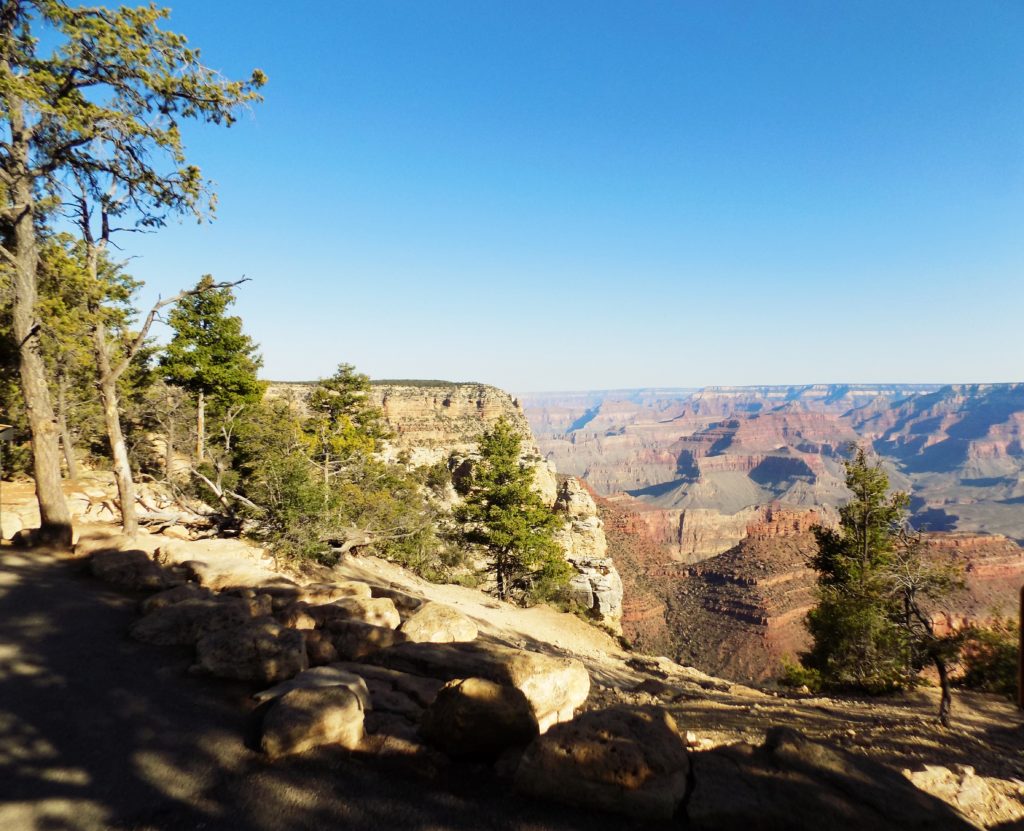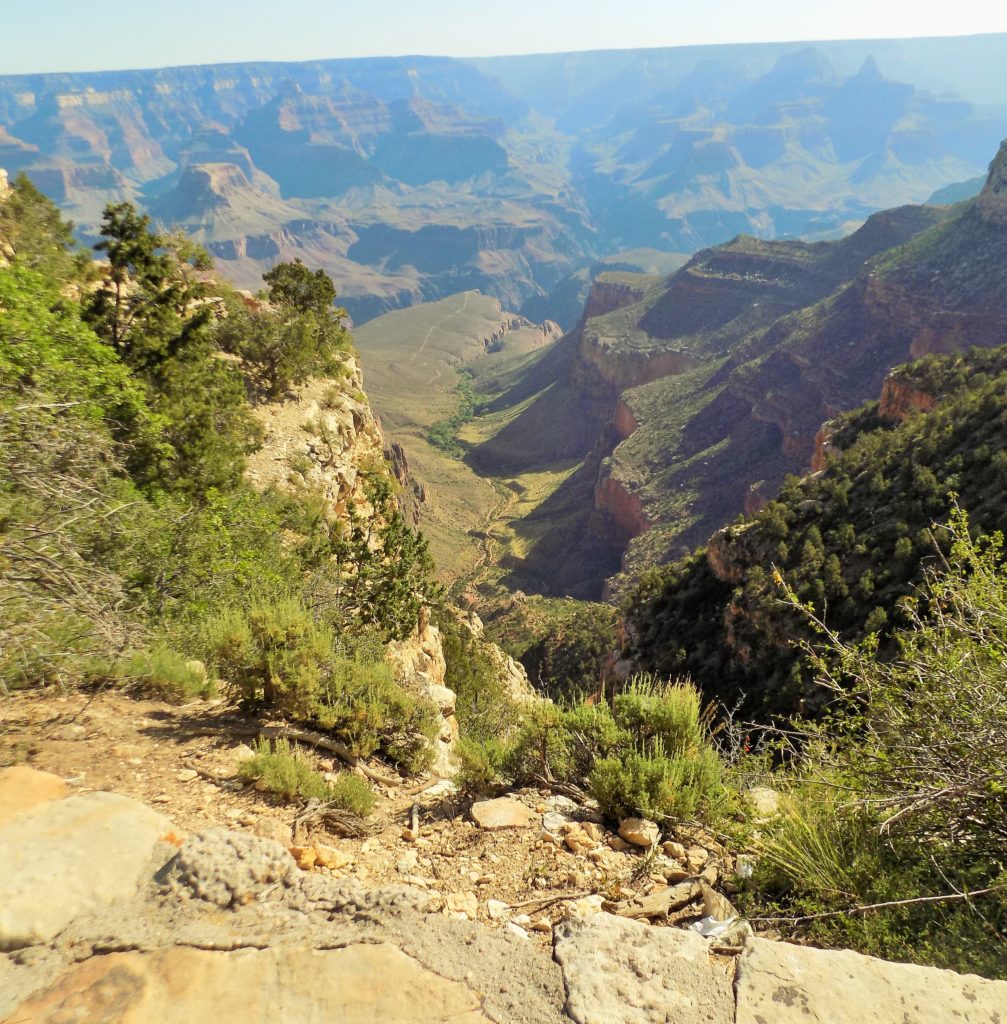Those of you who have read previous trip journals might recall that sections in blue are a digression and not necessarily directly related to my recounting of my travel. Most of this post is precisely that so feel free to skip to the bottom.
Never ask a canyon its age.
The picture below isn’t specifically tied to either the previous discussion or the one to follow but I thought you might want another peek at the canyon itself before I start my rant.
Now that I’ve provided a picture, I’m going to editorialize and put in my plug for science – particularly science versus religious dogma – because I believe that even if you have the baddest, meanest dogma imaginable, science will beat it in a fight every time. That’s not to say that I think science is somehow perfect. Quite the opposite, in fact. Science succeeds in expanding human knowledge through its imperfections. Good science tests its theories continually. Good science learns from its mistakes. Good science abandons hypotheses unsupported by evidence or theories contradicted by new evidence and seeks better answers. (For example, Einstein proposed the theory of general relativity in 1915 and it has now become not only foundational to our understanding of gravity but it’s embedded in our popular culture in myriad ways. Yet scientists, particularly astronomers, tested and challenged its predictions for more than a decade including years after Sir Arthur Eddington asserted its truth in 1919 before it finally gained broad acceptance between 1925 and 1930. {Jeffrey Crelinsten provides an in depth look at this process in his 2006 book Einstein’s Jury.})
And while I will neither begrudge nor belittle anyone’s spiritual beliefs, in the quest for knowledge, science is the road to discovery and god is a roadblock. Even the most brilliant scientists in all of human history have invoked god when reaching the limits of their knowledge or, to put it another way, when reaching the perimeter of their ignorance.
This has been true from Ptolemy to Galileo (who famously wrote that the Bible tells you how to go to heaven not how the heavens go) to Newton to Laplace and on down the line. Think of the relationship between Newton and Laplace. In 1687, Newton, someone at, or very near the top of the short list of the greatest minds our species has yet produced, published his Principia. In it he lays out in mathematical terms the principles of time, force, and motion that underpin much of our understanding of the universe still today.
But Newton had a problem. The differential integral calculus he invented worked perfectly in explaining the relationship between two bodies. For example, if you want to know what keeps the earth in its orbit around the sun, Newton’s calculus provides the answer. But the moon tugs on the earth necessitating another calculation to describe the relationship of the three bodies. On top of that, Newton knew of five other planets in the solar system and his theory of gravity showed that they all have some effect on each other depending on their various masses and distances – distances that varied throughout the year.
So, when he tried to calculate the gravitational effects of the moon, and Mars and Jupiter and Saturn on all these relationships, the calculations became too complex and the solar system became unstable. Its structure fell apart. It is at this point, and only at this point, in Principia that he evokes the notion of god, a creator or, if you will, intelligent design. And once he invokes god, he seems to lose his curiosity and stops looking for a solution to the problem.
What happened next? More than a century later, along came Pierre Laplace a brilliant mathematician who published a five-volume tome titled Celestial Mechanics. Laplace fine-tuned a branch of math known as perturbation theory that, while still imprecise due to certain effects of chaos theory, provided a description of the forces necessary to keep the solar system stable. While I’m no mathematician, I have been told that the mathematics of perturbation theory are simple enough that, had he continued looking, the man who invented calculus could have easily discerned them.
But god became the roadblock on Newton’s road to discovery. Conversely, when Napoleon, after reading Celestial Mechanics summoned Laplace and asked him what was the role of god in the construction and regulation of the heavens, the scientist is said to have simply replied, “I had no need of that hypothesis.”
I think one basic misconception many people have about science is linguistic in origin even if, strictly speaking, it shouldn’t be. This confusion stems from the conflict between the colloquial use of the word theory and its scientific or even its principal definition. In my experience, the most common conversational use of theory makes it synonymous with guess, speculation, or conjecture. According to Webster’s online dictionary, this would be the third and fifth of six possible usages. In science, a theory is a method for interpreting a set of observable facts. Webster’s puts it this way, “a plausible or scientifically acceptable general principle or body of principles offered to explain phenomena” e.g., the wave theory of light.
In science, a theory usually starts as a hypothesis or a series of hypotheses. The hypothesis is then tested and when enough evidence accumulates to support the hypothesis, it becomes a theory – in other words, a valid explanation of observed phenomena. It is different from a guess or conjecture. If enough evidence is observed to contradict a given theory, the theory is discarded and a search begins for a more plausible, more accurate theory. It’s not the facts that change but theories, or the way they are interpreted that changes. Rather than wedding itself to a notion, pushing, prodding, modifying, and discarding when the facts demand is what good science does.
And we can’t be selective in our choices of what science to believe or disbelieve because a theory conflicts with our personal dogma or economic interests. For example, scientists studying the annotation of genes, use a discipline that relies almost exclusively on comparative, or more precisely, evolutionary, approaches. Humans have carried out a form of artificial selection (as opposed to natural selection) for millennia.
In modern biology, such selection has become a vital part of genetic engineering, with selectable markers such as antibiotic resistance genes being used to manipulate DNA in molecular biology. It is also possible to use repeated rounds of mutation and selection to evolve proteins with particular properties, such as modified enzymes or new antibodies, in a process called directed evolution. To me, it borders on an unconscionable act of intellectual torpidity to accept the benefits from scientific inquiry based on evolution while, ignoring the evidence, and attempting to deny its application to a single species because of a dogmatic belief sprung from wholly non-scientific texts. I’m done for now.
Before I finish this post, here’s another random photo you can enjoy.
So, what does all this have to do with the age of the Grand Canyon? Well, it’s long been believed that the Colorado River began carving the Grand Canyon about six million years ago. There’s also some plausible evidence of erosion dating as far into the past as 17 million years. A 2012 study published in Science Magazine shocked geologists by pointing to the possibility that the canyon formed 70 million years ago. While the dating methods used in the 2012 study opened the possibility of a canyon far more ancient than previously believed, it didn’t fit well with the preponderance of the rest of the evidence regarding the canyon’s age.
And here’s where science does its work. The new evidence was tested and retested and a more plausible explanation arose. This examination demonstrated that, in all likelihood, the Grand Canyon as we know it today started out as a series of smaller canyons 70 million years ago, but the majority of the canyon didn’t begin to take shape until much more recently. Thus, two apparently conflicting sets of evidence are plausibly reconciled.
In 2015, researchers from Arizona State University published a paper in Geosphere that analyzed the topography of the western part of the Grand Canyon and compared it to other geological features that had been thoroughly and accurately dated as significantly older than 17 million years. Their results suggest that erosion on the walls of the western Grand Canyon occurred extremely quickly (geologically speaking), compared to those other areas. This established a high degree of confidence that the Canyon is younger than six million years and near certainty that it is less than 17 million years of age.
Thus, science continues its work.

